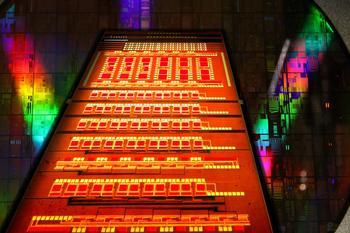 Recently, American scientists have created a new nano-scale connection device that can convert optical signals into waves that travel along a metal surface. More importantly, the new device can also recognize the polarization direction of polarized light and send signals in different directions accordingly.
Recently, American scientists have created a new nano-scale connection device that can convert optical signals into waves that travel along a metal surface. More importantly, the new device can also recognize the polarization direction of polarized light and send signals in different directions accordingly. Scientists said that the latest research provides a new way for people to accurately manipulate light at subwavelength scale without destroying signals that may carry data, which effectively transfers information from photonic devices to electronic devices. In order to achieve the next generation of single-chip photonic interconnection opens the door.
The research collaborator Balzaze Muller of the Harvard School of Engineering and Applied Science said: "If you want to send a data signal around a small chip with many components, then you need to be able to precisely control the signal. The direction of travel. If you cannot do this, the signal may be lost. Direction is an important factor in the success of the signal."
In the past, scientists could also control the direction of these waves by changing the angle at which light enters the surface of the connecting device. But as Muller puts it, "It's really troublesome. It's very difficult for optical circuits to be in a straight line, so it's not practical to constantly readjust the angle to set the signal."
The new connection device consists of a thin layer of gold covered with small holes. The genius that the scientists designed was in the same pattern as the fishbone fish bones (tails) formed by these incisions. The main author of the study, Professor Federico Capasso of the Faculty of Engineering and Applied Science at Harvard University, stated: "So far, scientists have used a series of parallel grooves (grids) to do this kind of thing, although It can also be done, but many signals will be lost, and the new structure on the new device will be able to use a very simple and elegant way to control the direction of the signal."
Now that light only needs to be injected vertically, the new device will do other things. It turns the incident light into a surface plasmon (dense waves propagate along the metal surface generated by free-vibrating electrons and photons that exist on the metal surface). It also reads the direction of polarization of the incident light wave—a straight line, left-hand circular polarization, or right-hand circular polarization—and then arranges the appropriate path for it. The new device can even split a beam of light into two parts and send different parts in different directions, which makes multi-channel information transfer possible.
The new structure is so tiny that each pattern unit is smaller than the wavelength of visible light. Therefore, scientists believe that the new structure should be easily integrated with novel technologies such as plane optics. However, Capasso said that the new equipment is most likely to be used in future high-speed information networks - nano-scale electronic devices (currently appearing), photonic devices and plasmas are expected to be integrated on a microchip, enabling the next generation Single-chip photonic interconnects.
Glass Plate,Coffee Table Glass,Coffee Table Tops
Processing Glass Tinted Glass Co., Ltd. , http://www.nsprocessingglass.com
![<?echo $_SERVER['SERVER_NAME'];?>](/template/twentyseventeen/skin/images/header.jpg)